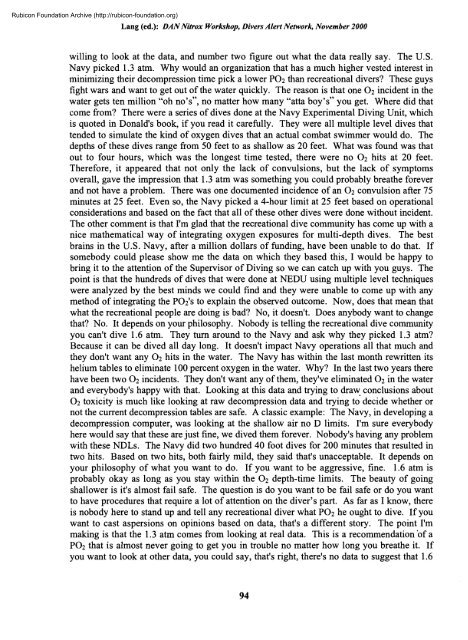Nitrox workshop dings - Divers Alert Network
Nitrox workshop dings - Divers Alert Network
Nitrox workshop dings - Divers Alert Network
Create successful ePaper yourself
Turn your PDF publications into a flip-book with our unique Google optimized e-Paper software.
Rubicon Foundation Archive (http://rubicon-foundation.org)Lang (ed.): DAN<strong>Nitrox</strong> Workshop, <strong>Divers</strong> <strong>Alert</strong> <strong>Network</strong>, November 2000willing to look at the data, and number two figure out what the data really say. The U.S.Navy picked 1.3 atm. Why would an organization that has a much higher vested interest inminimizing their decompression time pick a lower PO2 than recreational divers? These guysfight wars and want to get out of the water quickly. The reason is that one O2 incident in thewater gets ten million "oh no's", no matter how many "atta boy's" you get. Where did thatcome from? There were a series of dives done at the Navy Experimental Diving Unit, whichis quoted in Donald's book, if you read it carefully. They were all multiple level dives thattended to simulate the kind of oxygen dives that an actual combat swimmer would do. Thedepths of these dives range from 50 feet to as shallow as 20 feet. What was found was thatout to four hours, which was the longest time tested, there were no O2 hits at 20 feet.Therefore, it appeared that not only the lack of convulsions, but the lack of symptomsoverall, gave the impression that 1.3 atm was something you could probably breathe foreverand not have a problem. There was one documented incidence of an O2 convulsion after 75minutes at 25 feet. Even so, the Navy picked a 4-hour limit at 25 feet based on operationalconsiderations and based on the fact that all of these other dives were done without incident.The other comment is that I'm glad that the recreational dive community has come up with anice mathematical way of integrating oxygen exposures for multi-depth dives. The bestbrains in the U.S. Navy, after a million dollars of funding, have been unable to do that. Ifsomebody could please show me the data on which they based this, I would be happy tobring it to the attention of the Supervisor of Diving so we can catch up with you guys. Thepoint is that the hundreds of dives that were done at NEDU using multiple level techniqueswere analyzed by the best minds we could find and they were unable to come up with anymethod of integrating the PCVs to explain the observed outcome. Now, does that mean thatwhat the recreational people are doing is bad? No, it doesn't. Does anybody want to changethat? No. It depends on your philosophy. Nobody is telling the recreational dive communityyou can't dive 1.6 atm. They turn around to the Navy and ask why they picked 1.3 atm?Because it can be dived all day long. It doesn't impact Navy operations all that much andthey don't want any O2 hits in the water. The Navy has within the last month rewritten itshelium tables to eliminate 100 percent oxygen in the water. Why? In the last two years therehave been two O2 incidents. They don't want any of them, they've eliminated O2 in the waterand everybody's happy with that. Looking at this data and trying to draw conclusions aboutO2 toxicity is much like looking at raw decompression data and trying to decide whether ornot the current decompression tables are safe. A classic example: The Navy, in developing adecompression computer, was looking at the shallow air no D limits. I'm sure everybodyhere would say that these are just fine, we dived them forever. Nobody's having any problemwith these NDLs. The Navy did two hundred 40 foot dives for 200 minutes that resulted intwo hits. Based on two hits, both fairly mild, they said that's unacceptable. It depends onyour philosophy of what you want to do. If you want to be aggressive, fine. 1.6 atm isprobably okay as long as you stay within the O2 depth-time limits. The beauty of goingshallower is it's almost fail safe. The question is do you want to be fail safe or do you wantto have procedures that require a lot of attention on the diver's part. As far as I know, thereis nobody here to stand up and tell any recreational diver what PO2 he ought to dive. If youwant to cast aspersions on opinions based on data, that's a different story. The point I'mmaking is that the 1.3 atm comes from looking at real data. This is a recommendation of aPO2 that is almost never going to get you in trouble no matter how long you breathe it. Ifyou want to look at other data, you could say, that's right, there's no data to suggest that 1.694
















